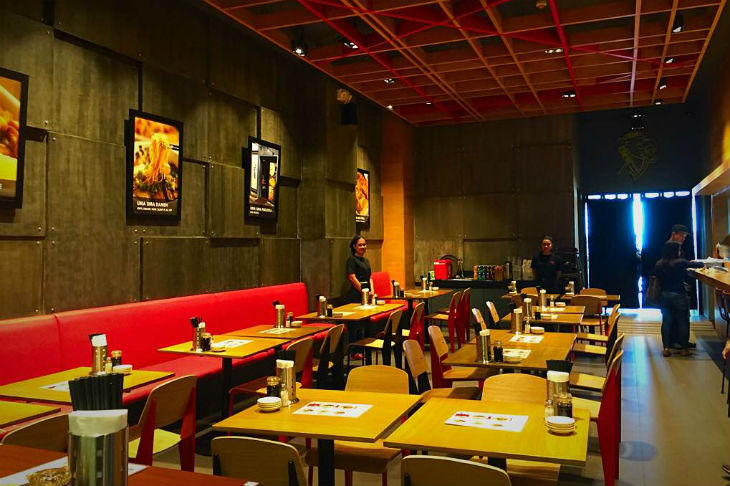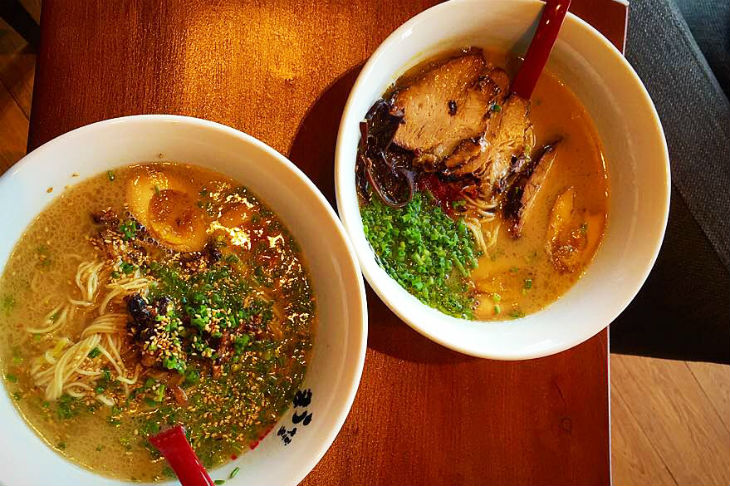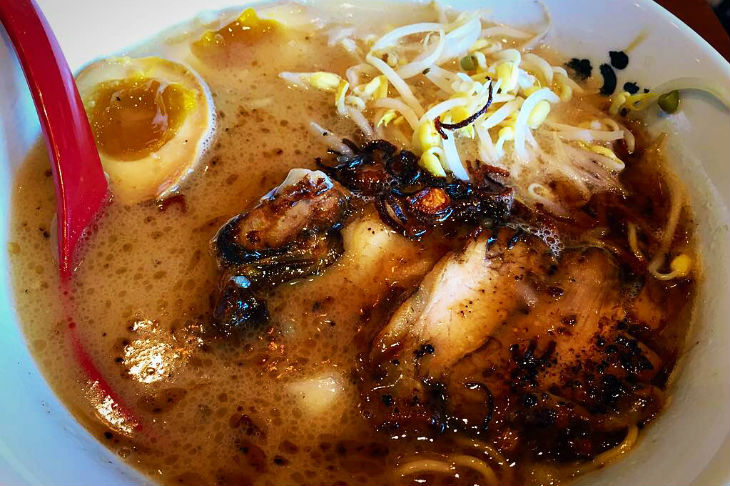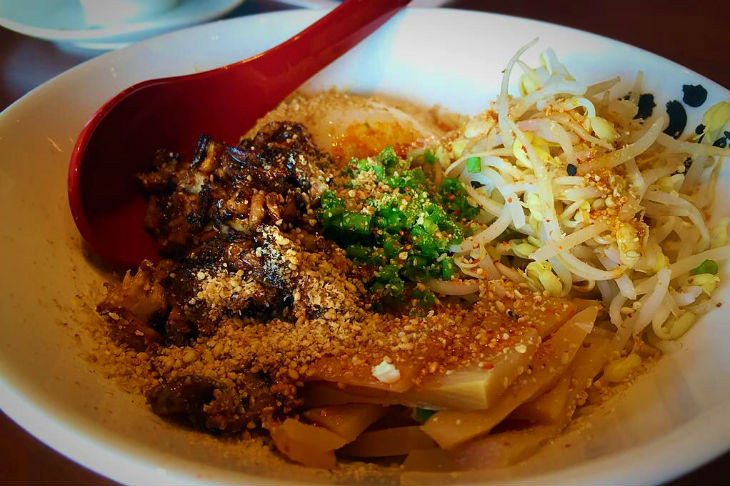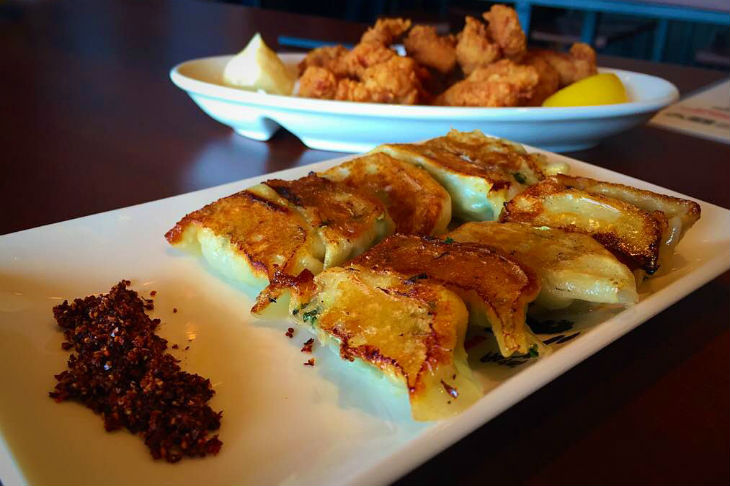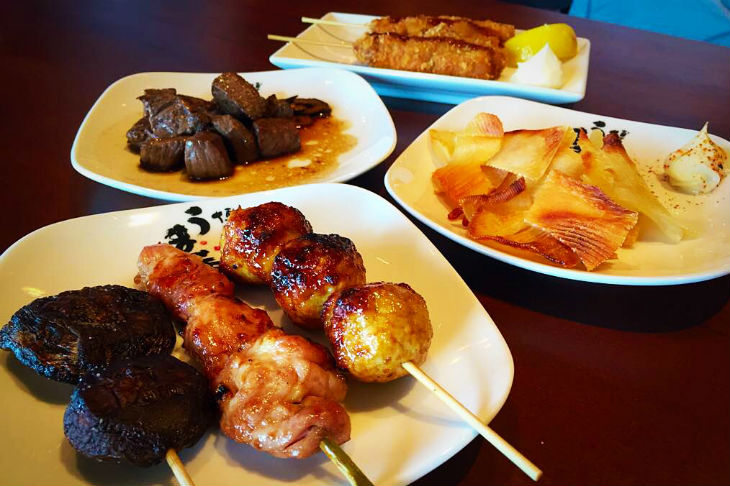New eats: Uma Uma Ramen opens at MOA's S Maison | ABS-CBN
ADVERTISEMENT

Welcome, Kapamilya! We use cookies to improve your browsing experience. Continuing to use this site means you agree to our use of cookies. Tell me more!
New eats: Uma Uma Ramen opens at MOA's S Maison
New eats: Uma Uma Ramen opens at MOA's S Maison
Joko Magalong
Published Jul 02, 2016 07:39 AM PHT
MANILA -- Despite being a latecomer to the ramen scene in the Philippines, Uma Uma Ramen aims to take its share of the market by offering its own brand of progressive ramen.
MANILA -- Despite being a latecomer to the ramen scene in the Philippines, Uma Uma Ramen aims to take its share of the market by offering its own brand of progressive ramen.
“We are blessed that we have the breadth to be able to explore different kinds of noodle dishes, and not stick to strictly traditional Japanese recipes,” said Russell Yu from Iki Concepts of Singapore, which brought Uma Uma Ramen to the Philippines.
“We are blessed that we have the breadth to be able to explore different kinds of noodle dishes, and not stick to strictly traditional Japanese recipes,” said Russell Yu from Iki Concepts of Singapore, which brought Uma Uma Ramen to the Philippines.
Uma Uma Ramen has been in the business for more than 60 years, starting with a single ramen shop in Fukuoka, Japan. It has since expanded to eight outlets, which can be found in Thailand, Singapore, and now the Philippines.
Uma Uma Ramen has been in the business for more than 60 years, starting with a single ramen shop in Fukuoka, Japan. It has since expanded to eight outlets, which can be found in Thailand, Singapore, and now the Philippines.
It’s all about the bones in Uma Uma Ramen, which serves 100% MSG-free Hakata-style ramen.
It’s all about the bones in Uma Uma Ramen, which serves 100% MSG-free Hakata-style ramen.
ADVERTISEMENT
“The original ramen that we have is the tonkotsu broth. As opposed to adding flavor by adding umami with MSG, we use more bones and boil for a longer period of time to achieve a higher level of flavor and concentration. So slightly higher cost for us, but we feel the quality that we produce is great,” said Yu.
“The original ramen that we have is the tonkotsu broth. As opposed to adding flavor by adding umami with MSG, we use more bones and boil for a longer period of time to achieve a higher level of flavor and concentration. So slightly higher cost for us, but we feel the quality that we produce is great,” said Yu.
Hakata-style ramen is one of the more popular styles, and has mainly propelled the ramen movement throughout the world (and in the Philippines as well). Pork bones are not gently simmered, but are put on full boil for a long time until everything is broken down and mixed in, resulting in a broth that’s milky white, thick and rich.
Hakata-style ramen is one of the more popular styles, and has mainly propelled the ramen movement throughout the world (and in the Philippines as well). Pork bones are not gently simmered, but are put on full boil for a long time until everything is broken down and mixed in, resulting in a broth that’s milky white, thick and rich.
In Uma Uma Ramen, the broth is simmered for at least 12 hours, with no MSG additives. It guarantees no stickiness or heaviness in the mouth, only full-bodied porky flavor.
In Uma Uma Ramen, the broth is simmered for at least 12 hours, with no MSG additives. It guarantees no stickiness or heaviness in the mouth, only full-bodied porky flavor.
To taste the most straightforward version of their bowls, try the Tonkotsu Ramen. It has all the basics — pork chasiu bits, spring onions, sesame seeds, and tamago (egg).
To taste the most straightforward version of their bowls, try the Tonkotsu Ramen. It has all the basics — pork chasiu bits, spring onions, sesame seeds, and tamago (egg).
The Spicy Chasiu Ramen, meanwhile, is red and fiery with spicy chasiu, potent chili oil, black fungus, tamago, and some spring onions for some herby flavor.
The Spicy Chasiu Ramen, meanwhile, is red and fiery with spicy chasiu, potent chili oil, black fungus, tamago, and some spring onions for some herby flavor.
ADVERTISEMENT
While most ramen places will give you garlic on the side to be pressed raw into the broth (which you can also do here), Uma Uma’s Garlic Ramen already comes to you imbued with garlic flavor. It’s unmistakably garlic without being too overpowering, and the garlic oil as well as the other condiments like fried shallots and bean sprouts add to its robust taste.
While most ramen places will give you garlic on the side to be pressed raw into the broth (which you can also do here), Uma Uma’s Garlic Ramen already comes to you imbued with garlic flavor. It’s unmistakably garlic without being too overpowering, and the garlic oil as well as the other condiments like fried shallots and bean sprouts add to its robust taste.
Last but not the least is Uma Uma Ramen. The ramen shop’s signature dish features chasiu, black fungus, spring onions, tamago and a dollop of spicy miso. It’s the spicy miso that makes this bowl sing, giving it more umami flavor and body, but surprisingly, not making it too rich.
Last but not the least is Uma Uma Ramen. The ramen shop’s signature dish features chasiu, black fungus, spring onions, tamago and a dollop of spicy miso. It’s the spicy miso that makes this bowl sing, giving it more umami flavor and body, but surprisingly, not making it too rich.
MORE THAN JUST RAMEN
“Mazesoba was something we did for Singapore, and it worked so well that we introduced it to Japan,” Yu said of this dish.
“Mazesoba was something we did for Singapore, and it worked so well that we introduced it to Japan,” Yu said of this dish.
While ramen bowls use thin, straight and white noodles, the dry-noodle Mazesoba uses yellow curly soba, similar to the look and thinness of Japanese dry/instant ramen noodles. But the similarity ends there.
While ramen bowls use thin, straight and white noodles, the dry-noodle Mazesoba uses yellow curly soba, similar to the look and thinness of Japanese dry/instant ramen noodles. But the similarity ends there.
This dish is really a must-try. Sauced with the mixture of runny poached (onsen) egg, and a soy-chili sauce at the bottom of the bowl, this is a bowl of noodles that seems at once both familiar and different. It’s like a gourmet version of instant chili Pansit Canton. That is if you’ve ever topped instant chili pansit canton with a sunny side egg with a runny yolk, and mixed it all together. But, of course, this one has zero MSG, and tastes leaps and bounds better than the instant stuff. I predict that Filipinos will love this dish. It’s vegetarian on its own, but you can always upgrade it with some additional chasitu. And as the chasiu is braised and then grilled before serving, you get the bonus of deep chargrilled flavors.
This dish is really a must-try. Sauced with the mixture of runny poached (onsen) egg, and a soy-chili sauce at the bottom of the bowl, this is a bowl of noodles that seems at once both familiar and different. It’s like a gourmet version of instant chili Pansit Canton. That is if you’ve ever topped instant chili pansit canton with a sunny side egg with a runny yolk, and mixed it all together. But, of course, this one has zero MSG, and tastes leaps and bounds better than the instant stuff. I predict that Filipinos will love this dish. It’s vegetarian on its own, but you can always upgrade it with some additional chasitu. And as the chasiu is braised and then grilled before serving, you get the bonus of deep chargrilled flavors.
ADVERTISEMENT
Other non-ramen fare include Japanese favorites like the convenient one-bite gyozas, and crispy chicken karaage. Come 5 p.m. though, Uma Uma's izakaya menu becomes available.
Other non-ramen fare include Japanese favorites like the convenient one-bite gyozas, and crispy chicken karaage. Come 5 p.m. though, Uma Uma's izakaya menu becomes available.
The back part of the ramen shop is dubbed “the Horse’s Mouth” (a play on the Uma Uma name, as uma means ‘horse’ in Japanese) where guests can sip on drinks and eat from the izakaya menu, which includes yakitori (grilled), and kushikatsu (fried) items.
The back part of the ramen shop is dubbed “the Horse’s Mouth” (a play on the Uma Uma name, as uma means ‘horse’ in Japanese) where guests can sip on drinks and eat from the izakaya menu, which includes yakitori (grilled), and kushikatsu (fried) items.
From chicken skin, grilled mushrooms, pork belly skewers, beef tips, to dried fried sting ray, each dish is savory and designed to go well with alcohol, with the view of the magnificent Manila sunset as an added extra.
From chicken skin, grilled mushrooms, pork belly skewers, beef tips, to dried fried sting ray, each dish is savory and designed to go well with alcohol, with the view of the magnificent Manila sunset as an added extra.
Iki Concepts plans to put up another Uma Uma Ramen shop within the year at the newly opened Uptown Parade in Taguig.
Iki Concepts plans to put up another Uma Uma Ramen shop within the year at the newly opened Uptown Parade in Taguig.
And while the Philippine ramen market is getting more competitive as time goes by with most of the major players already here, Uma Uma Ramen promises to bring something new to the table.
And while the Philippine ramen market is getting more competitive as time goes by with most of the major players already here, Uma Uma Ramen promises to bring something new to the table.
ADVERTISEMENT
“We’re working on a few local flavor driven ramens, and that’ll be quite interesting,” quipped Yu.
“We’re working on a few local flavor driven ramens, and that’ll be quite interesting,” quipped Yu.
ADVERTISEMENT
ADVERTISEMENT



